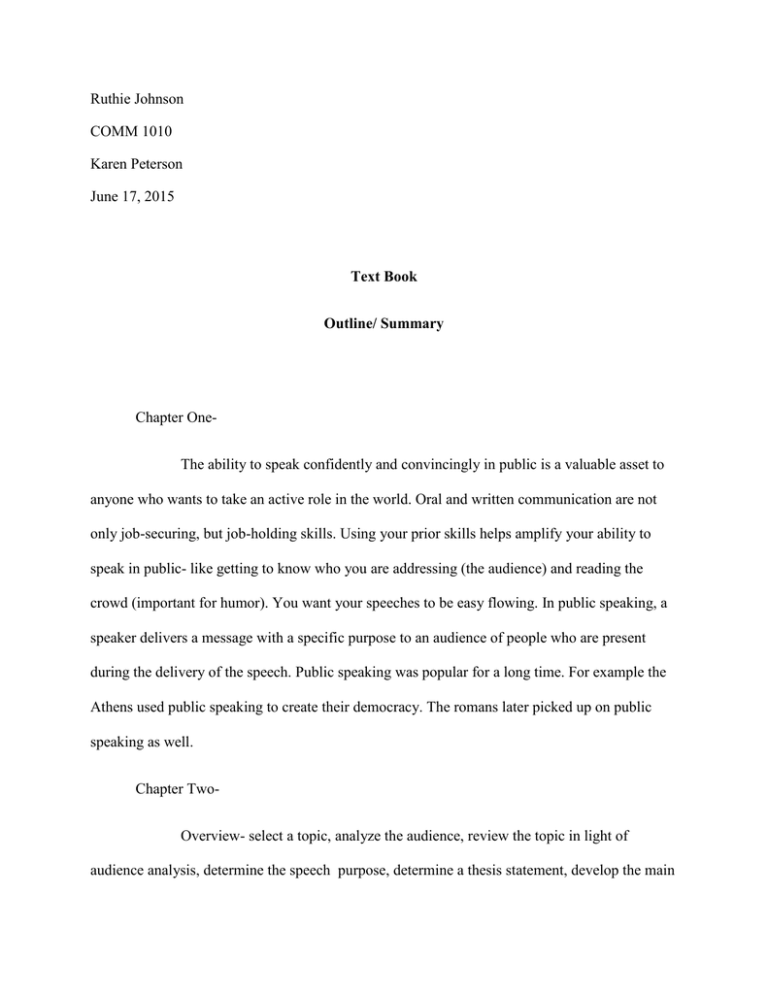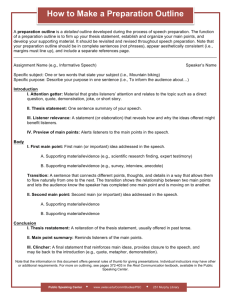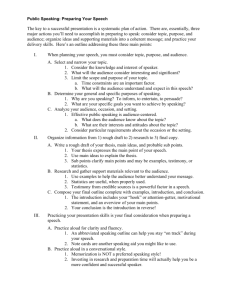File - Ruthie's Eportfolio
advertisement

Ruthie Johnson COMM 1010 Karen Peterson June 17, 2015 Text Book Outline/ Summary Chapter OneThe ability to speak confidently and convincingly in public is a valuable asset to anyone who wants to take an active role in the world. Oral and written communication are not only job-securing, but job-holding skills. Using your prior skills helps amplify your ability to speak in public- like getting to know who you are addressing (the audience) and reading the crowd (important for humor). You want your speeches to be easy flowing. In public speaking, a speaker delivers a message with a specific purpose to an audience of people who are present during the delivery of the speech. Public speaking was popular for a long time. For example the Athens used public speaking to create their democracy. The romans later picked up on public speaking as well. Chapter TwoOverview- select a topic, analyze the audience, review the topic in light of audience analysis, determine the speech purpose, determine a thesis statement, develop the main points, gather supporting materials, separate the speech into its major parts, outline the speech, consider presentation aids, practice delivering the speech. There are three types of speeches; informative, persuasive, and special occasion. Chapter Three Different speech anxieties. I have performance anxiety-where I get extremely nervous right before the speech and during. Have a clear and thorough plan – this will help with your anxiety. Prepare and practice your speech many times. Another tip is to rather than envision your speech as a performance, visualize it as an extended conversation. Visualize success. Seek pleasure in the occasion. Stretching an hour before can also reduce anxiety jitters. Learn from feedback. Chapter Four This chapter is on ethical public speaking. Earn your listeners trust. Ethics means character. Respect your audiences values especially when giving a talk on a controversial subject. Orally acknowledge your sources to avoid plagiarism. Your speech should also have a works cited page where you can put your sources. Chapter Five Listening is the conscious act of receiving, comprehending, interpreting, evaluating, and responding to messages. To become a better listener practice listening. Eliminate distractions and focus on what is being said rather than the speaker. Chapter Six To give an effective speech one must be aware of their audience. Who is listening? Taking the measure of the audience is critical because people tend to evaluate messages in terms of their own, rather than the speaker’s perspective. People rely on their attitudes to judge a person, or their speech. Attitudes are based on beliefs-the ways in which people perceive reality. It is easier to captivate an audience with positive attitudes toward your topic. Appeal to listeners’ attitudes, beliefs, and values. Pay close attention to the length of your speech. Consider age, ethnic or cultural background, socioeconomic status (including income, occupation, and education), religion, Political affiliation, and gender. Chapter Seven Selecting a topic and purpose. Decide where you want to begin. Again consider the audiences values and beliefs. Narrow the topic, form a specific speech purpose, compose a thesis statement,. Make the thesis statement relevant and motivating. Express it in a way that will motivate the audience to listen. Chapter Eight Good speeches contain accurate, relevant, and interesting supporting material in the form of examples, narratices, testimony, facts, and statistics. Examples illustrate, describe, or represent things. On of the most powerful means of conveying a message is through a story (also called a narrative). Provide facts and statistics. Again refer orally to your sources, your audience needs to know how accurate your speech is. Chapter Nine Locating supporting material. Resources can come from books, newspapers and periodicals, government publications, encyclopedias, almanacs, books of quotations, poetry collections, atlases, weblogs and social news sites. Referencing your sources is easiest when you cite them during your progress. Chapter Ten Doing effective internet research can be difficult. When searching for scholarly articles try searching through a library search engine, this eliminates the popular articles on shoes and stuff. An example of a library is posted on the salt lake community college website. You must be able to distinguish among information, propaganda, misinformation, and disinformation. Information is data that are understandable and have the potential to become knowledge when viewed critically and added to what we already know. Propaganda is information represented in such a way as to provoke a desired response. Misinformation always refers to something that is not true. Disinformation is the deliberate falsification of information. Smart web searching is also more common knowledge. No Wikipedia, and if it has .org rather than .com it is more likely to be more accurate. Also record your internet sources just like any other source. (slightly different format.) Chapter Eleven Citing sources in your speech is critical in order to avoid plagiarism. During a speech you are supposed to mention where you got your information orally. So just having a bibliography isn’t sufficient. Many examples on pages 88-90. All have hanging indenting. Chapter Twelve Every speech has a way about how it is organized. A speech structure is simple, composed of just three general parts: an introduction, a body, and a conclusion. Main points are found within the body. Main points should flow directly from the speech goal and thesis. Speech should also include Specific purpose (goal of the speech), thesis (the central idea of the speech), Main points (in roman numerals). You should restrict the number of main points, avoid dragging out your speech. Your main points should be one idea expressed in a complete sentence. Supporting points support your main points. Use indentation to make paper visually attractive and organized. Keep speech balanced; body should be the section that you focus most or longest on. Transitions are the glue that holds the speech all together. The more smooth the transition is the more smooth your speech is. Transitions are often posed in restate-forecast form, restating the point just covered and previewing the point to be covered next. Chapter Thirteen Selecting an organizational pattern is also very important. There are a few different ways you can organize your speech. A few examples are chronologically, spatial pattern (small items and larger), Cause-Effect patterns, problem-solution patterns, topically, and arranging speech points using the narrative pattern. Chapter Fourteen Outlining the speech. You will make two copies, one for the teacher and one for you, the speaker. Use sentences, phrases, and key words, when making your outline. Create the main speech points, note any obvious subpoints, select an organizational pattern for the main points, create a working outline, organize main points and sub-points, check main points and subpoints for coordination and subordination, and finally transfer the working outline to a speaking outline. Don’t forget to have an introduction, body, conclusion, and especially transitions. Practice your speech using the speech outline. The working outline Is a little different. Kind of like a rough draft. Chapter Fifteen Developing the introduction and conclusion for your speech. The choices you make about the introduction can affect the outcome of the entire speech. Within the first 90 seconds your listeners will decide whether or not they are interested or if they will believe what you say. Some tools for an effective introduction are; use a quotation, tell a story, pose questions, relate unusual information, use humor, refer to the audience, refer to the occasion, all these need to preview the topic and purpose of your speech. The final function of the introduction is to motivate the audience to care about your topic and believe what you say about it. For this to happen your audience must believe that 1. The topic is relevant, and 2. That you are qualified to address it. Making the audience believe that you are qualified to address it can be done by sharing some experience, knowledge, or perspective that you have that is different from or more extensive than that of your audience. To create an effective conclusion some tools are; Signal the end of the speech and provide closure, summarize the key points, repeat the topic and speech purpose, challenge the audience to respond, and make the speech memorable. You want your message will linger after the speech is over. You can make it memorable by using the same tools you used to create your effective introduction. Chapter sixteen When preparing your speech remember to use a language which your audience can understand. Strive for simplicity, be concise, make frequent use of repetition, use personal pronouns, use concrete language (example summer – concrete sweltering heat), offer vivid imagery, choose words that build credibility, use words appropriately, use words accurately, use the active voice, use culturally sensitive and gender-neutral language, choose words that create a lasting impression. Chapter Seventeen Choosing a method of delivery is very important. Strive for naturalness and enthusiasm. You can speak from manuscript, speak from memory, speak impromptu, speak extemporaneously. Impromptu is when your speech is spontaneous and unpracticed. Extemporaneously falls somewhere between impromptu and written or memorized deliveries. Chapter Eighteen The volume of a speaker is usually the first thing we notice. Vary your intonation. (stop. Stop!) adjust your speaking rate- the pace at which you convey speech. Make sure you don’t talk too fast. Pauses enhance meaning by providing a type of punctuation, emphasizing point, drawing attention to a key thought, or just allowing listeners a moment to contemplate what is being said. Strive for vocal variety. Use all the above tool s together rather than separately. Carefully pronounce and articulate words. Avoid mumbling. A dialect is a distinctive way of speaking associated with a particular region or social group. Use dialect with care. Chapter Nineteen This chapter is titled using the body. Pay attention to body language. As a n audience listens to you they are also evaluating your body language- eye contact, posture, and facial expressions. Animate your facial expressions, maintain eye contact, use gestures that feel natural, be aware of general body movement (avoid fidgeting), dress appropriately, practice the delivery, focus on the message, and plan ahead. Chapter Twenty This chapter is titled types of presentation aids. You should select an appropriate aid for your speech. Consider using a prop or model. Graphs can also be helpful. You can have charts, audio or video, overhead transparencies, digital projectors, prepare a flip chart, use posters, and REHEARSE. Chapter Twenty-One This chapter is titled designing presentation aids. Make it simple. Use design elements consistently. Select appropriate typeface styles and fonts. Use color carefully- make sure they contrast correctly. Consider subjective interpretations of color. Chapter Twenty-Two A brief guide to Microsoft power point is in chap 22. Some of its main points are; give a speech, not a slideshow, develop effective slides, and avoid technical glitches. Chapter Twenty- Three This chapter discusses informative speaking.. enlighten rather than advocate. Demonstrate the topic’s relevance early on, use audience analysis, present new and interesting information, help listeners follow along. Take these steps to reduce confusion- use analogies to build on prior knowledge, demonstrate underlying causes, appeal to different learning styles, and check for understanding by checking feedback. Don’t forget the works cited page! Chapter Twenty-Four Persuasive speaking is one of the different kinds of speaking. Focus on motivation. Balance reason and emotion. Stress your credibility. Target listener’s needs. Encourage mental engagement. Construct sound arguments. In an argument, you offer a conclusion about some state of affairs, support it with evidence, and then link the evidence to the claim with reason. Identify the nature of your claims. Use convincing evidence. Use effective reasoning. Avoid fallacies in reasoning. Address culture. Strengthen your case by using organization. Here are a few patterens; Problem-solution patterns – problem (define what it is) solution (offer a way to overcome the problem) Monroe’s motivated sequence- step 1 attention, step 2 need, step 3 satisfaction, step 4 visualization, step 5 action. Chapter Twenty-Five A special occasion speech is one that is prepared for a specific occasion and for a purpose dictated by that occasion. The object of a speech of introduction is to prepare of “warm up” the audience for the main speaker- to heighten audience interest and build the speaker’s credibility. A speech of acceptance is made in response to receiving an award. The goal of the speech of presentation is twofold: to communicate the meaning of the award and to explain why the recipient is receiving it. A roast is a humorous tribute to a person, one in which a series of speakers jokingly poke fun at him or her. A toast is a brief tribute to a person or an event being celebrated. Those delivering eulogies are charged with celebrating and commemorating the life of someone while consoling those who have been left behind. The contemporary after-dinner speech is just as likely to occur before, during, or after a lunch seminar or other type of business, professional, or civic meeting as it is to follow a formal dinner. Lighthearted and entertaining. A speech of inspiration seeks to motivate listeners to positively consider, reflect on, and sometimes act on the speaker’s words.



